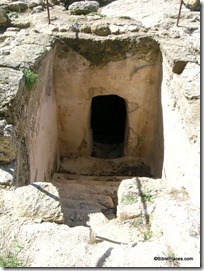Scientists have discovered evidence for cultivation of three of the “four species” of Sukkot in the plaster of walls at Ramat Rahel.
A model of the Temple Mount made by Conrad Schick in 1872 will be on display next week in the new Heritage Center of Christ Church, Jerusalem.
Leen Ritmeyer has notice of a program to be held on the 20th anniversary of Nahman Avigad’s death.
Yosef Garfinkel is pretty upset with Rami Arav’s review of the first excavation report of Khirbet
Qeiyafa. [Update: The post has been removed. See comment below for detail.]
The world’s largest Israeli flag is now flying over Nazareth Illit.
Joe Yudin suggests visiting some sites from King David’s life when the wildflowers are blooming.
The 50th anniversary of the publication of The Dead Sea Scrolls in English, by Geza Vermes, was celebrated last week at Wolfson College.
Bedouin gunmen in Sinai kidnapped two US tourists traveling from Jebel Musa. They were released when Egyptian police set free four Bedouin who had been in custody.
The first snowfall in Rome in 26 years kept visitors out of the Colosseum, the Forum, and Palatine Hill.
HT: Jack Sasson
UPDATE (2/7): At the request of the sponsors, I’ve removed the link to the invitation to the (private)
presentation at Christ Church.

5 thoughts on “Weekend Roundup”
Hi Todd: The link regarding Garfinkel/Arav's does not seem to go to anything relevant. Am I missing something? Thanks as always.
Mike – the post has been deleted, but it is still visible in Google Reader. Yosef Garfinkel and Saar Ganor wrote:
The Bulletin of the American Schools of Oriental Research recently published a book review by Dr. R. Arav on our final excavation report for the 2007–2008 seasons at Khirbet Qeiyafa (BASOR 364:93–97). This review falsely attributes many absurd claims to the site’s excavators—for example, that the Iron Age city of Khirbet Qeiyafa was destroyed by rain.
Another notable vulgar statement is found on page 95: “If we are to take the assumptions of the authors seriously—that Tell Qeiyafa is indeed the Judahite She`arayim, situated in ‘Efes Damim,’ the battlefield of David and Goliath, and was not deserted in a peaceful manner—then could it be that the match between David and Goliath was not as narrated in the Bible and that the Judahites actually lost this battle?”
Dr. Arav presents here a mixture of factual inaccuracy and fantasy. Khirbet Qeiyafa suddenly appears with a new name: “Tell Qeiyafa,” and is turned into the site of biblical Efes Damim (a claim never made in our report). The biblical account, of disputed historical value, places the battle between David and Goliath in the Valley of Elah while Khirbet Qeiyafa is located on a hilltop above a valley. The biblical story describes the military force against the Philistines as “Saul and the men of Israel” (1 Sam 17:2, Revised Standard Version) while Dr. Arav turns these into “Judahites.” It is of little comfort that not only Qeiyafa I is subject to abuse in this review, but the Bible as well. Click here for the full-length response, in which we reply to 18 erroneous points in Dr. Arav’s review.
[The link to the full response still works: http://www.asor.org/blog/Garfinkel.pdf%5D
The original post is also available from Google:
http://webcache.googleusercontent.com/search?q=cache:oLqtTQBpPwoJ:asorblog.org/%3Fp%3D1494+&cd=2&hl=en&ct=clnk&gl=us
Thanks Todd. Helpful as always.
Todd, I was able to pre-view the Conrad Schick model last week with S. Gibson. It is truly fantastic and I encourage anyone with interest to come to the presentation on Feb. 12. They'll learn a ton.
blessings,
bill